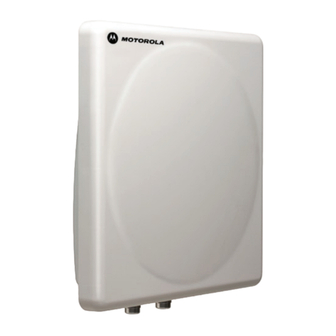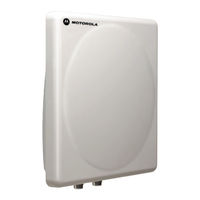
Motorola MOTOWI 4 PTP 600 Series Solution Manuals
Manuals and User Guides for Motorola MOTOWI 4 PTP 600 Series Solution. We have 6 Motorola MOTOWI 4 PTP 600 Series Solution manuals available for free PDF download: System User Manual, User Manual, Parts List, Deployment Manual
Motorola MOTOWI 4 PTP 600 Series User Manual (250 pages)
Point-to-Point Wireless Bridges
Brand: Motorola
|
Category: Wireless Access Point
|
Size: 3.42 MB
Table of Contents
-
-
-
Region Codes42
-
Distance46
-
-
-
Preparation52
-
Powering up65
-
-
8 Web
68-
Install102
-
Disarm114
-
Software Upgrade117
-
Barring Channels126
-
Diagnostics139
-
License Key143
-
Properties145
-
Reboot146
-
9 Recovery Mode
147-
Reboot156
-
10 Fault Finding
157-
Hardware157
-
Power157
-
Ethernet158
-
Radio160
-
No Activity160
-
Some Activity161
-
-
-
Overview163
-
-
12 Wind Loading
174 -
-
Scope177
-
Hardware177
-
Antenna Choices178
-
Status Page179
-
Configuration180
-
Installation181
-
Link Budget184
-
Installation188
-
Antenna Choice188
-
Tools188
-
-
-
Overview203
-
-
-
License Keys216
-
-
UK Notification222
-
Exposure222
-
Legal Notices222
-
18 Glossary
228 -
19 Faqs
229 -
20 Index
232 -
-
Management242
-
Ethernet243
-
Physical244
-
Powering244
-
Ghz Variant245
-
Ghz Variant247
Advertisement
Motorola MOTOWI 4 PTP 600 Series User Manual (242 pages)
POINT-TO-POINT WIRELESS BRIDGE
Brand: Motorola
|
Category: Wireless Access Point
|
Size: 3.21 MB
Table of Contents
-
-
-
Region Codes41
-
Distance46
-
-
-
Preparation52
-
Powering up64
-
-
8 Web
67-
Install100
-
Install Pages100
-
Disarm112
-
Software Upgrade115
-
Barring Channels124
-
Diagnostics137
-
License Key141
-
Properties143
-
Reboot144
-
9 Recovery Mode
145-
Reboot153
-
10 Fault Finding
154-
Hardware154
-
Power154
-
Ethernet155
-
Radio157
-
No Activity157
-
Some Activity158
-
-
-
Overview159
-
-
12 Wind Loading
170 -
-
Scope173
-
Hardware173
-
Status Page175
-
Configuration176
-
Installation177
-
Link Budget181
-
Installation185
-
Antenna Choice185
-
Tools185
-
-
-
Overview200
-
-
-
License Keys213
-
-
UK Notification219
-
Exposure219
-
Legal Notices220
-
18 Glossary
225 -
19 Faqs
226 -
20 Index
229 -
-
Management236
-
Physical237
-
Powering237
-
Ghz Variant238
-
Ghz Variant240
Motorola MOTOWI 4 PTP 600 Series System User Manual (278 pages)
Series Point-to-Point Wireless Bridges
Brand: Motorola
|
Category: Network Router
|
Size: 3.13 MB
Table of Contents
-
Region Codes50
-
Recovery Mode162
-
Fault Finding171
-
Wind Loading186
-
Link Budget196
-
Specifications265
Advertisement
Motorola MOTOWI 4 PTP 600 Series User Manual (61 pages)
PTP Solutions Guide Motorola Fixed Point-to-Point Wireless Bridges
Brand: Motorola
|
Category: Network Hardware
|
Size: 1.87 MB
Table of Contents
Motorola MOTOWI 4 PTP 600 Series Parts List (38 pages)
Wireless Ethernet Bridge
Brand: Motorola
|
Category: Network Router
|
Size: 9.66 MB
Table of Contents
Motorola MOTOWI 4 PTP 600 Series Deployment Manual (23 pages)
Brand: Motorola
|
Category: Network Hardware
|
Size: 0.52 MB





